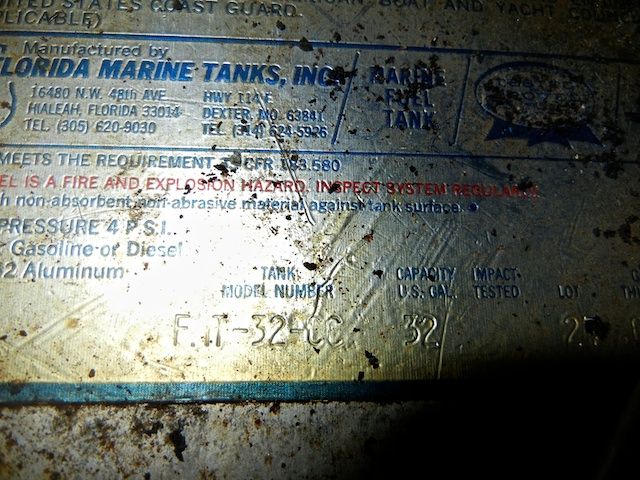Replacing a 30-year Old Fuel Tank
--Blog post written by Bob
I had noticed small signs of leakage of diesel fuel just forward of the fuel tank for years. It probably dribbled into the bilge and mixed with other fluids before it was pumped overboard by the bilge pump.
 |
| Oily leakage thru bulkhead just forward of fuel tank |
Lately, I noticed the bilge had more oil content. The last time I changed the filter element in the Racor fuel filter (September) I noticed some type of oily substance caked on the filter element (it looked like a oil-soaked plastic foam). These two things coupled together created a serious concern about the integrity of the 30-year old aluminum fuel tank.
I had read Wally Bryant's blog about his fuel tank replacement and decided to do some research on the original fuel tank. I called South Shore Yachts, a supplier of old C&C parts in Canada but they were not helpful in this effort. I managed to find a label on the old fuel tank, Florida Marine Tanks. Fortunately they are still in business but needed more info from the label to make a replacement tank. I managed to reach a small point and shoot camera (set on macro mode) into the area where the label was located and with several attempts I was able to retrieve the needed information (specifically the model number) to find the original drawings.
 |
| Label on old fuel tank captured with a point and shoot camera |
It turns out that the original tank holds 32 gallons (probably only 30 usable gallons) and it was 0.090 inches thick. Florida Marine Tanks told me the minimum thickness for a replacement today is 1/8-inch thick (0.125 inches). I had no idea when the leak had started since it is encapsulated with fiberglass structure on the lower two thirds of the tank. So, I decided that 1/4-inch was the thinnest replacement tank I would consider and got a quote on the upgraded replacement (over $500). Because it was such a big job to replace the tank (the steering quadrant and below deck auto pilot had to be removed for installation), I asked my regular boatyard for a quote on the job with me supplying the tank--the estimated cost of replacement is 10 to 20 times the cost of the tank!
I ordered the 1/4-inch thick aluminum tank and scheduled the replacement for December (a slow time in the boat yard). I also ordered a special corrosion-resistant coating on the outside of the tank--I was initially reluctant to add this because we are taking steps to avoid the encapsulation of the bottom which probably caused the corrosion (salt water exposure on the outside).
No comments:
Post a Comment